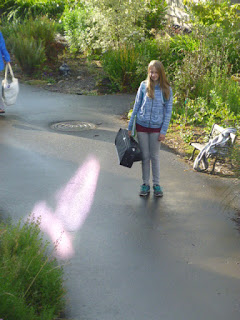I've been meditating in a secluded part
of our property under a canopy of trees since it got warm and stopped
raining. My eyes are nourished by the many shades of green, my ears
by the dawn chorus of bird sounds and distant traffic, and my skin
and lungs appreciate the crisp freshness of the morning air. After a
brief break indoors, due to chilly, rainy weather, I returned to my
spot to find an abundance of Swainson's thrush activity. A thrush
would 'wheet' insistently off to my right for a while, then flit
across my field of vision and 'wheet' off to the left, then behind
me. I assumed it was a baby 'wheeting' for food. This continued for 8
days. On two occasions I had startled an anonymous bird in the bush
next to my spot when I put my chair down, but I didn't think anything
of it. On one day two thrushes flitted about in trees directly in
front of the spot I stare at. Finally, on the eighth day, after
hearing a fluttering of wings near my left ear, and realizing that it
was not the first time I had heard this, it dawned on me that I might
be near a nest. I looked into the bush immediately to my left, and
there was a dark mass at eye level (I was seated), with a white feather on it. When I got up to
leave, I looked more closely, and there were 3 eggs in a nest. I
could have reached into the bush from where I sat and touched the
nest. All of the assumed baby 'wheeting' turned out to be stress
calling and diversionary tactics from panicked parents.
I start anticipating the arrival of the
Swainson's thrushes around March, even though I know I won't hear one
until May. The geese are on their way home to Canada and their low
flying over the property at various times (always a time to stop and
relish the sense of wonder) will be missed. The sound of the
Swainson's thrush (https://www.youtube.com/watch?v=lpLnRUnoJNQ)
is a special treat we only get in summer, when the geese are gone.
At the end of May this year, when we were clearing things away from
the building in anticipation of our new paint job, I found a dead
Swainson's thrush, most certainly a victim of a window collision.
Sad, and also wondrous to be that close to one, to hold the lifeless
body and admire the reddish brown feathers, I left it in the common
house so everybody could see it.
Now that I knew about the nest, I felt
a sense of responsibility for it. On the day of the discovery, I gave
a tour to some folks who happened to be birders. I told them about
the nest, and we attempted to see it, but frightened mom off the nest
as we approached. They told me that looking at a nest can alert
predators to its whereabouts, so we did not attempt to get close.
The nest was located three to four feet off the ground on a path used
by people (but always empty when I'm there in the early morning),
and clearly visible if one knew where to look, so I kept it mostly
secret. When I went out in the mornings, I passed by the bush and
went to an open meadow area, without drawing attention to it. Upon
leaving, I would frequently see a bird leave the bush from afar, and
I knew that all was well. On the fifth day after 'discovery,' I
sensed that something was amiss and looked into the bush. The nest
was tipped forward and its contents were nowhere to be found. The
grass under the nest was smashed, otherwise, no details of the theft
were visible to my novice eyes. One morning, a month or so before, a
raccoon came crashing up the hill toward that very spot. There are
also feral cats in the area, the occasional house cat, dogs, and for
a brief time years ago, a mink lived in our compost bins. We can only
hope that the parent thrushes learned a lesson and will build a nest
in a more protected spot.
I took the beautifully built nest,
constructed of twigs, moss, and lichen. The larger sticks were
threaded into the bush and held it securely, until unknown predator
pulled the nest over. We suspect the white feather came from
some domesticated geese in the neighborhood. You can see it at my house, or here:







